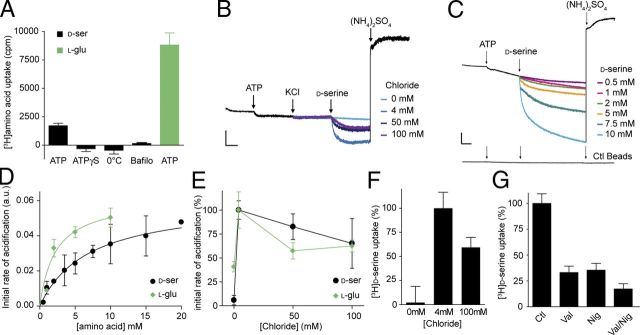Figure 7.
Features of vesicular d-serine uptake into astrocytic immunopurified vesicles. A, ATP-dependent uptake of d-[3H]serine and l-[3H]glutamate. The values represent FCCP-sensitive uptake. FCCP (40 μm) was added together with MgATP (4 mm). Control experiments are performed by replacing MgATP by ATPγS (4 mm), by decreasing temperature to 0°C, or by inhibiting V-ATPase with bafilomycin A1 (1 μm). B, d-Serine (7.5 mm)-mediated acidification of GVs is dependent on chloride (the figure shows representative traces from 3–6 independent measurements). To maintain ionic strength and osmolarity, chloride was exchanged for gluconate (potassium salts). Arrows correspond to addition of the tested compound [10 mm ATP and 50 mm (NH4)2SO4, final concentrations in this and the following figures]. At the end of the reaction, (NH4)2SO4 was added to dissipate ΔpH. C, Overlay of photometric traces showing acidification of GVs induced by various d-serine concentrations in the presence of 4 mm chloride (representative of 3–5 independent experiments). No change in fluorescence under any condition was observed when control (Ctl) beads (mouse IgG) were used. Scale bars, 2 arbitrary units per 1 min. D, Dependence of the initial rate of acidification on d-serine and l-glutamate concentration. E, F, Initial rate of acidification induced by d-serine (7.5 mm) or l-glutamate (5 mm) and d-[3H]serine uptake were measured in the presence of different chloride concentrations. G, Influence of both components of the proton electrochemical potential ΔμH+ on FCCP-sensitive ATP-dependent d-[3H]serine uptake. Additions: 5 μm nigericin (Nig), 20 μm valinomycin (Val). Error bars represent mean ± SEM; n = 3–6 independent experiments.

